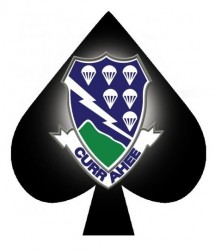101st Airborne “Currahees,” Decommissioning Date Moved Up
The U.S. Army 4th Brigade Combat Team of the 101st Airborne, the “Currahees” that trace their beginnings to Camp Toccoa and the Band of Brothers in World War II, is being decommissioned earlier than first planned.
According to an Associated Press report, 140 soldiers from the “Currahees” returned to Fort Campbell, Kentucky from their final deployment to Afghanistan last week.
That report indicates that the 101st is one of 10 brigade combat teams set for decommissioning by the Army. The U.S. Army recently announced the shutdown process for those teams would be moved up to 2015 from 2017 because of budget cuts.
The 4th Brigade Combat Team Traces got its start in 1942 with the original 506th Parachute Infantry Regiment, which trained at Camp Toccoa on Currahee Mountain.
The City of Toccoa has long celebrated its role in American military history with the annual Currahee Military Weekend and the recent construction of the Currahee Military Museum, which depicts the role of the 506th Parachute Regiment, now the 101st Airborne, during World War II.
Stephens County Historical Society Executive Director Brenda Carlan says that regardless of what happens to the unit, the legacy of the “Currahees” will live on.
“The ‘Currahees’ will not go away,” said Carlan. “Here in Toccoa, this is what we are doing, trying to keep the legacy of the ‘Currahees’ alive.
She added it would still be present at Fort Campbell as well.
“If you ever have the opportunity to go, everywhere you look you are going to be reminded of the ‘Currahees,’ said Carlan. “The streets are and will remain named after Currahee and Toccoa and different things, things they tie into their history and that would be the history that goes back to the training of the 506th here for World War II.”
Members of the 4th Brigade Combat Team have been to Toccoa multiple times, coming from Fort Campbell to run the three miles and three miles down Currahee Mountain and trace the footsteps of those who served in the unit before them.

